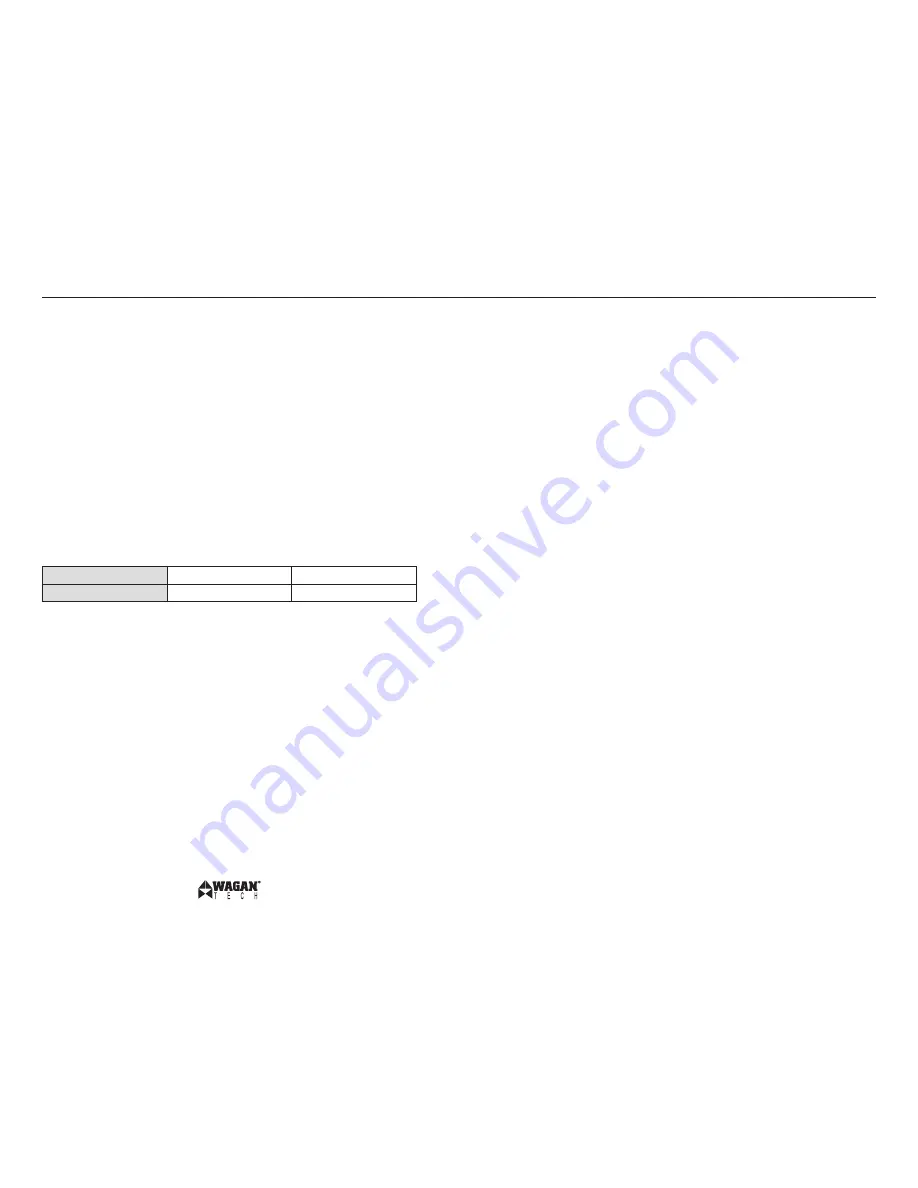
ProLine
™
�5���W�Power�Inverter�by�Wagan�Tech
®
www.wagan.com
11
©�����Wagan�Corporation.�All�Rights�Reserved.
Wagan�Tech�and�
wagan.com
�are�trademarks�used�by�Wagan�Corporation.
User’s�Manual—Read�before�using�this�equipment
12
DC�CABLE�GAGE�
Minimize�cable�losses�by�using�the�thickest�insulated�stranded�copper�wire�
available,�and�the�shortest�practical�length.�Refer�to�“Appendix�A”�at�the�rear�of�this�
manual�for�suggested�cable�gauge.
INSTALLATION—CONNECTING AN INVERTER
GENERAL�INFORMATION
This�inverter�must�be�mounted�in�a�dry,�cool�and�dust�free�environment.�
If�installation�is�on�a�wall�or�bulkhead,�the�inverter�should�be�mounted�horizontally.�
Vertical�mounting�allows�dust�and�objects�to�fall�into�inverter�vents.
Loose�connections�will�result�in�a�severe�voltage�drop�that�can�cause�damage�to�
connectors,�conductors�and�insulation�and�can�cause�sparking.�Reverse�polarity�
connection�will�blow�the�fuses�in�the�inverter�and�can�permanently�damage�to�the�
inverter.�Damage�caused�by�reverse�polarity�will�void�the�warranty.�
NOTE:�There�are�two�sets�of�DC�input�terminals�to�ease�cable�connections�and�
reduce�the�need�for�larger�gage�cables.�No�single�terminal�can�carry�more�current�
than�described�as�follows:
Watts
�5��
5���
Terminal Sets
�
�
All�cables�must�be�made�of�stranded,�insulated�copper�wire.�Measure�the�round�trip�
length�of�cable�needed.�Round�trip�is�the�distance�from�the�negative�battery�bank�
terminal�to�the�inverter�and�back�to�the�positive�terminal�of�the�battery�bank.�Use�
a�length�of�string�and�follow�the�route�the�cables�will�follow.�Measure�the�length�of�
string�and�then�determine�the�correct�gauge�cable�required�for�the�power�level�and�
total�distance.�Appendix�A�has�a�table�that�relates�cable�length�and�gauge�for�your�
inverter.�Measure�all�terminal�stud�diameters�that�are�to�be�connected�to�cables.�
Obtain�ring�terminals�that�fit�the�cables�and�terminal�studs.�Be�sure�the�ring�terminals�
can�carry�the�current�required.
GROUND�TERMINAL�WIRE�REQUIREMENTS
Use�a�minimum�of�6�gauge�stranded�wire�for�enclosure�ground�wire.�Connect�this�
to�the�chassis�of�your�vehicle�or�to�the�grounding�system�in�your�boat.�In�a�city,�
the�ground�wire�can�connect�to�a�metal�cold�water�pipe�that�goes�underground.�In�
remote�locations,�the�ground�wire�can�be�connected�to�an�“earth�ground”.�This�can�
be�an�attachment�to�a�6�foot�long�copper�clad�metal�rod�driven�into�the�ground.�In�
the�unlikely�event�of�a�short�circuit,�operating�the�inverter�without�proper�grounding�
can�result�in�electrical�shock.�Do�not�directly�connect�this�ground�to�the�negative�
terminal�on�the�inverter.
CABLE�PREPARATION
�.� Strip�all�cable�ends�to�allow�crimping�of�Ring�Terminals.
�.� Crimp�appropriate�sized�ring�terminals�onto�all�cable�ends�including�fuse�
holder�cable�ends.
3.� Connect�the�fuse�holders�to�the�long�positive�(+)�cable�terminals.
4.� Connect�the�fuse�holders�to�the�short�positive�(+)�cable�terminals.
5.� Wrap�the�inverter�positive�cable�ends�with�insulating�plastic�wrap.
6.� Mount�the�fuse�holders�to�a�support�structure.
7.� Install�fuses�in�the�fuse�holders�and�tighten�the�retaining�nuts.
8.� Install�the�Ground�wire�from�the�inverter�enclosure�to�the�grounding�point.
WARNING: THE PROCEDURE THAT FOLLOWS IS FOR SAFE CONNECTION TO
MINIMIZE INITIAL CONNECTION SPARKING AND DAMAGE FROM UNPROTECTED
BATTERY CABLE SHORTS.
Making�the�first�connection�between�the�positive�cable�and�the�inverter’s�positive�
terminal�may�cause�a�spark.�This�is�a�normal�and�is�a�result�of�capacitors�in�the�
inverter�starting�to�charge.�Because�of�the�possibility�of�sparking,�it�is�extremely�
important�that�both�the�inverter�and�the�battery�bank�be�positioned�away�from�any�
source�of�flammable�fumes�or�gases.�Failure�to�heed�this�warning�can�result�in�fire�
or�explosion.�Do�not�make�the�first�positive�terminal�connection�immediately�after�
batteries�have�been�charging.�Allow�time�for�the�battery�gasses�to�vent�to�outside�
air.�
INVERTER�TO�BATTERY�CONNECTION�PROCEDURE
�.� Disconnect�any�Remote�Switch�Connector�from�the�front�panel�of�the�inverter.
�.� Make�sure�the�ON/OFF�switch�located�on�the�front�panel�of�the�inverter�is�in�
the�OFF�position.
3.� Install�all�non-fused�(negative)�cables�from�the�negative�battery�bank�
terminal�to�the�Negative�(−)�Terminals�on�the�rear�of�the�inverter.�
4.� Tighten�the�retaining�nuts.
5.� Connect�all�fuses�end�positive�cable�ring�terminals�to�the�positive�battery�
bank�terminal.
6.� Carefully�tighten�the�retaining�nuts.�DO�NOT�SHORT�BATTERY�POSITIVE�TO�
NEGATIVE�OR�GROUND.�
7.� At�the�inverter�end�carefully�unwrap�one�positive�cable�end�and�connect�it�to�
one�Positive�Terminal.�A�spark�is�likely�to�result.�This�is�normal.�
8.� Tighten�the�retaining�nut.�BE�CAREFUL;�DO�NOT�SHORT�THE�POSITIVE�
TERMINAL�TO�THE�GROUNDED�INVERTER�ENCLOSURE.�
9.� Continue�installing�the�remaining�positive�cables.





























